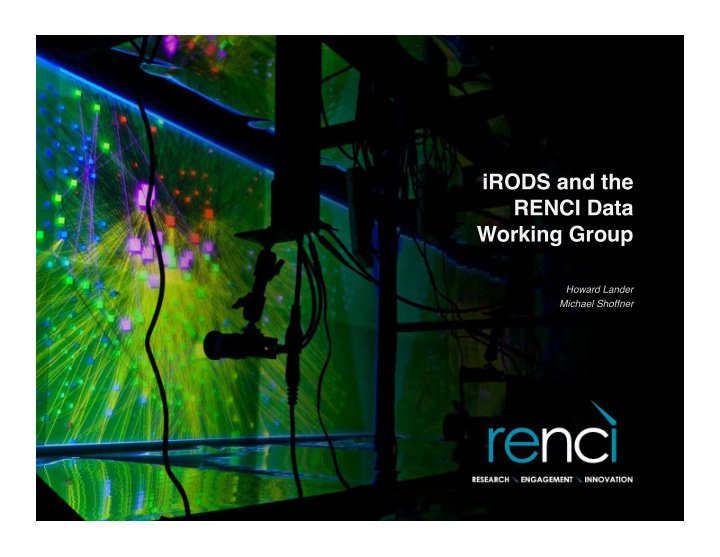



iRODS and the RENCI Data Working Group Howard Lander Michael Shoffner
The Renaissance Computing Institute • Formed in 2004 as a collaborative institute involving the University of North Carolina at Chapel Hill, Duke University and North Carolina State University. • RENCI develops and deploys advanced technologies to enable research discoveries and practical innovations. • This science of cyberinfrastructure is essential to continuing scientific discovery and innovation. iRODS and the RENCI Data Working Group 2
RENCI Resources • A diverse group of people including domain scientists in oceanography, meteorology, chemistry, informatics and computer science. • A diverse set of projects and collaborators spanning the domains listed above and more. • Several compute clusters with an aggregate peak computing power of approximately 30 Teraflops. • More than one Pb of spinning disk. • An ideal laboratory to develop the science of cyberinfrastructure iRODS and the RENCI Data Working Group 3
The Data Working Group • Chartered in May 2010, as an outgrowth of discussions that started in late 2009. • Motivated by the realization that RENCI had a number of ongoing projects with significant data challenges. • Existing projects and knowledge were confined to project specific stove pipes. No way to run an Institute! iRODS and the RENCI Data Working Group 4
RENCI Data Working Group • Is responsible for providing leadership and strategic guidance for RENCI in the data technology area. • Includes data architecture, technology research, development and operations, and dissemination and education. • RDWG focuses on large scale research-based data challenges such as very large scale data sets, distributed data sets, multi-institutional data collections and novel analysis and visualization approaches. iRODS and the RENCI Data Working Group 5
Procedures and Practices • Meetings every two weeks. • Provide consulting services and discussion forum for new projects and proposals. • Catalog data needs, architectures, successes and failures of existing projects. Goal is to establish a set of design patterns for management of large amounts of scientific data. • Maintain an archive of NSF style data management plans to assist proposal writers. iRODS and the RENCI Data Working Group 6
The Data Working Group and iRODS • A close collaborative relationship between RENCI and the DICE Center. • Arcot Rajasekar and Reagan Moore are RDWG members and regular contributors. • We have several projects with iRODS involved: • National Climatic Data Center: Next Few Slides. • RENCI Sequencing Initiative: Charles Schmitt. iRODS and the RENCI Data Working Group 7
National Climatic Data Center Project • NCDC is in Asheville, NC. Worlds largest archive of weather data. Some data is over 150 years old and there is data collected by Thomas Jefferson and Benjamin Franklin. • One of the data sets is an archive of radar precipitation estimates. • RENCI and NCDC are collaborating on a pilot program produce a repeatable scalable workflow with this data set. • Project has a computational component and a data management component. iRODS and the RENCI Data Working Group 8
National Climatic Data Center Project • Computation occurs at RENCI on our Blue Ridge cluster. • Combines 9 overlapping precipitation estimates to produce a single mosaic estimate. Period of the study is 10 years. • Radar mosaic is augmented with “truth on the ground” to produce a high resolution gridded data set. Result set is known as “Q2”. Must be returned to NCDC, but is small compared to the input data. • So what ʼ s the problem? iRODS and the RENCI Data Working Group 9
National Climatic Data Center Project • RENCI wants to save copy of Q2 and share it with other collaborators. • Input data for calculation is low 10 ʼ s of Tb ʼ s. • Input data is not at RENCI: it ʼ s behind a firewall at NCDC. • The computation is not one calculation: it ʼ s hundreds to thousands of “embarrassingly parallel” tasks. Easily separated without much interdependency. • Too many jobs to launch at once and too much data to move at once. • Can iRODS help? iRODS and the RENCI Data Working Group 10
National Climatic Data Center Project • Saving Q2 and sharing is easy. Replication and federation. • First usage so far is data transfer. iRODS data transfer using iput is much faster than scp. NCDC uses iRODS client to the iren data grid at RENCI. • scp: 2.8 MB/s • iput: 32.8 MB/s • Big improvement! Fast enough? iRODS and the RENCI Data Working Group 11
National Climatic Data Center Project • Naïve case: transfer all the data, then run all the jobs. Answer: Nope, still not fast enough. 32.8 MB/s is less than 3 Tb per day. Tie up the network completely for 10 days for 30Tb. • Still have the problem of overrunning our shared computational queue. There must be a better idea. If only … iRODS and the RENCI Data Working Group 12
National Climatic Data Center Project • Tie file transfer and job submission together in iRODS. • iRODS would estimate download time for input data and remaining run time for job. When these 2 times are equal, iRODS would begin downloading the needed input data. When the data has arrived, iRODS would start the job. • iRODS could maintain a job queue, to handle this process for multiple concurrent jobs. • May require iRODS/Globus integration. • Similar to double/multiple buffering in graphics. iRODS and the RENCI Data Working Group 13
RENCI Sequencing Initiative • Consists of several RENCI collaborations. • Deep Sequencing Studies for Stimulant Dependence with Kirk Wilhelmsen (UNC School of Medicine). • National Institutes of Health Exome Project with Kari North (UNC Epidemiology) and Ethan Lange (UNC Genetics). iRODS and the RENCI Data Working Group 14
Contact information Howard Lander <howard@renci.org> Michael Shoffner <shoffner@renci.org> iRODS and the RENCI Data Working Group 15
Recommend
More recommend